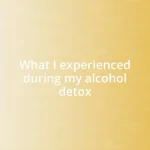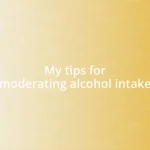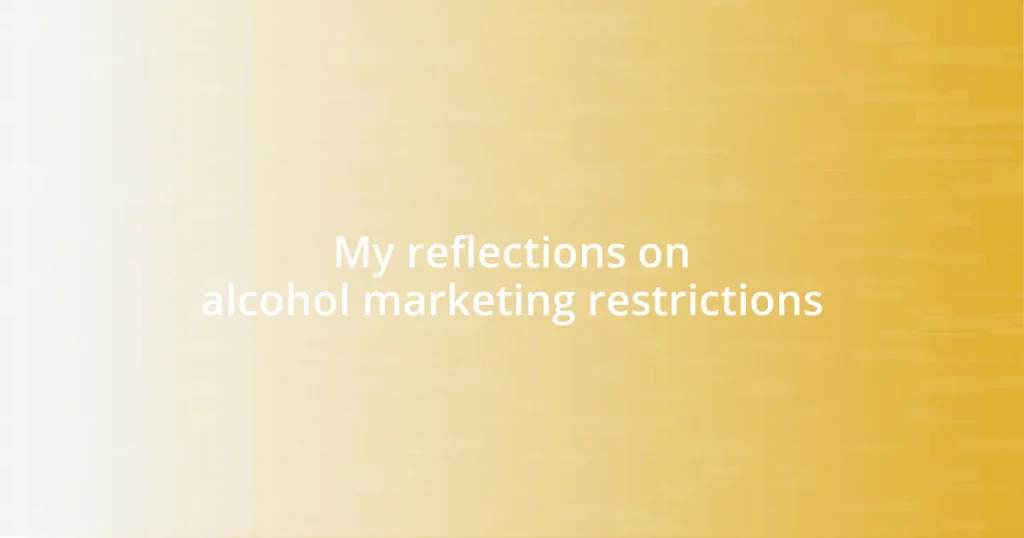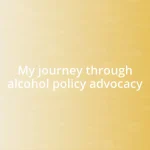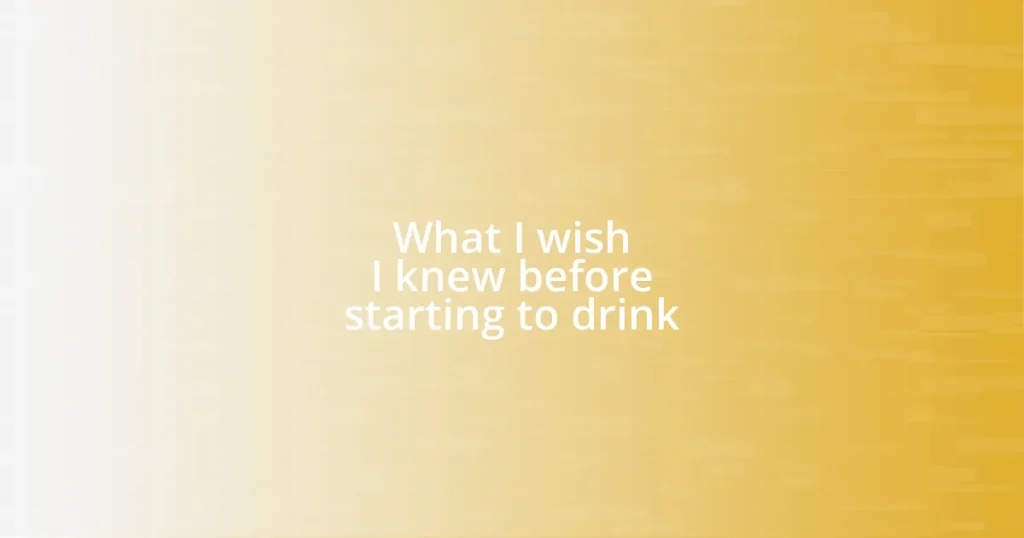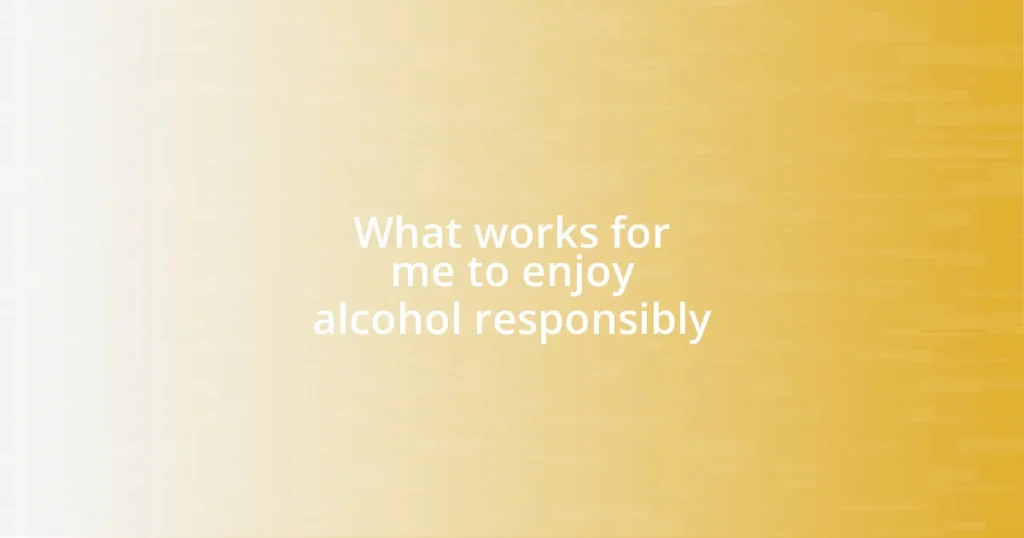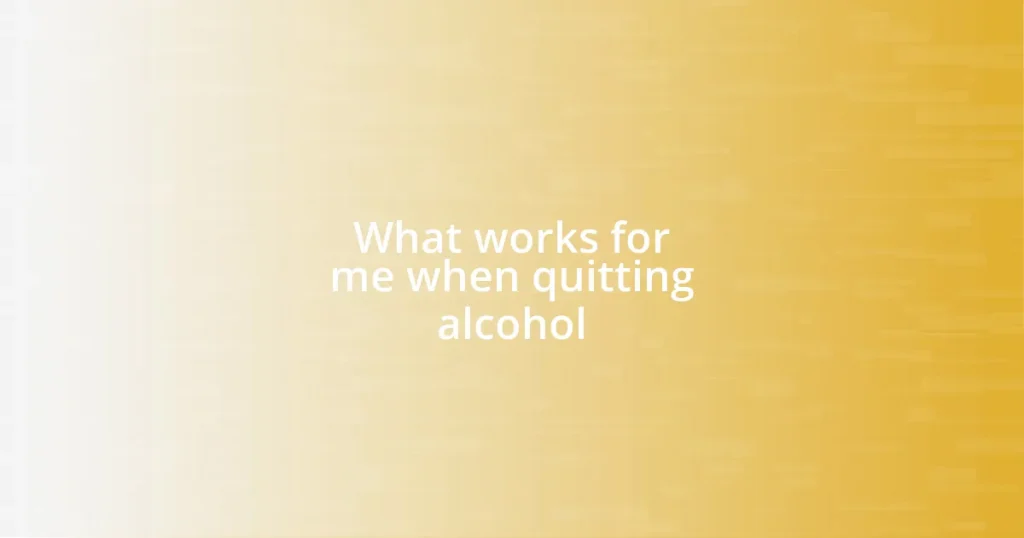Key takeaways:
- Alcohol marketing restrictions aim to protect vulnerable populations, especially youth, while encouraging responsible advertising practices.
- Marketing significantly influences drinking behaviors and social settings, normalizing heavy drinking through desirable portrayals and emotional storytelling.
- Successful campaigns, like those promoting responsible consumption through community stories and health partnerships, highlight the potential for positive societal impact through marketing.
- Future trends in alcohol advertising may include greater transparency, technological engagement, and partnerships with public health organizations to foster a culture of conscious consumption.
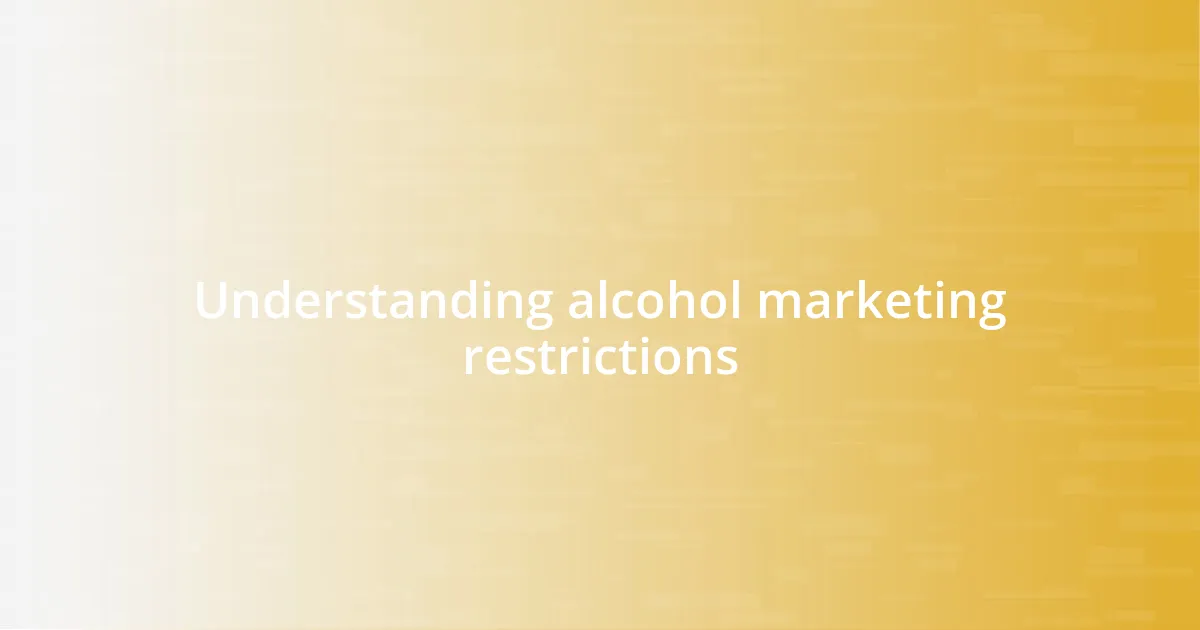
Understanding alcohol marketing restrictions
Alcohol marketing restrictions are designed to mitigate the potential harms associated with excessive drinking. From my personal experience, I’ve noticed that these regulations often target specific platforms and audiences, which can result in some creative yet responsible advertising. Have you ever wondered how these limitations shape the way brands communicate their message?
One of the most significant aspects of alcohol marketing restrictions is the emphasis on protecting vulnerable populations, particularly young people. I remember a time when I came across a beer advertisement that cleverly played on youthful rebellion, but it raised my eyebrows. Isn’t it fascinating how closely these laws attempt to draw the line between marketing creativity and social responsibility?
Moreover, the restrictions established by various countries can differ dramatically, affecting how brands operate in different markets. This inconsistency is intriguing; I’ve seen brands adapting their strategies based on local laws, often leading to unique promotional campaigns that reflect cultural values. Isn’t it remarkable what lengths companies will go to engage their audience while navigating regulatory frameworks?

Impact of marketing on consumption
The impact of marketing on alcohol consumption is both profound and complex. I recall a summer gathering where I noticed how the presence of a vibrant, eye-catching beer ad transformed the atmosphere—it felt like the product was almost a centerpiece. This experience made me realize that the way these products are marketed can significantly influence social settings and drinking behaviors. People often gravitate towards brands that resonate with their lifestyle, sometimes leading to increased consumption just because of clever marketing touches.
- Alcohol advertisements can create a sense of desirability, making it seem trendy to participate in drinking culture.
- Targeting young adults with relatable messages can normalize heavy drinking as part of social activities.
- Emotional storytelling in ads can evoke nostalgia or happiness, influencing consumers to reach for a drink as a form of escapism.
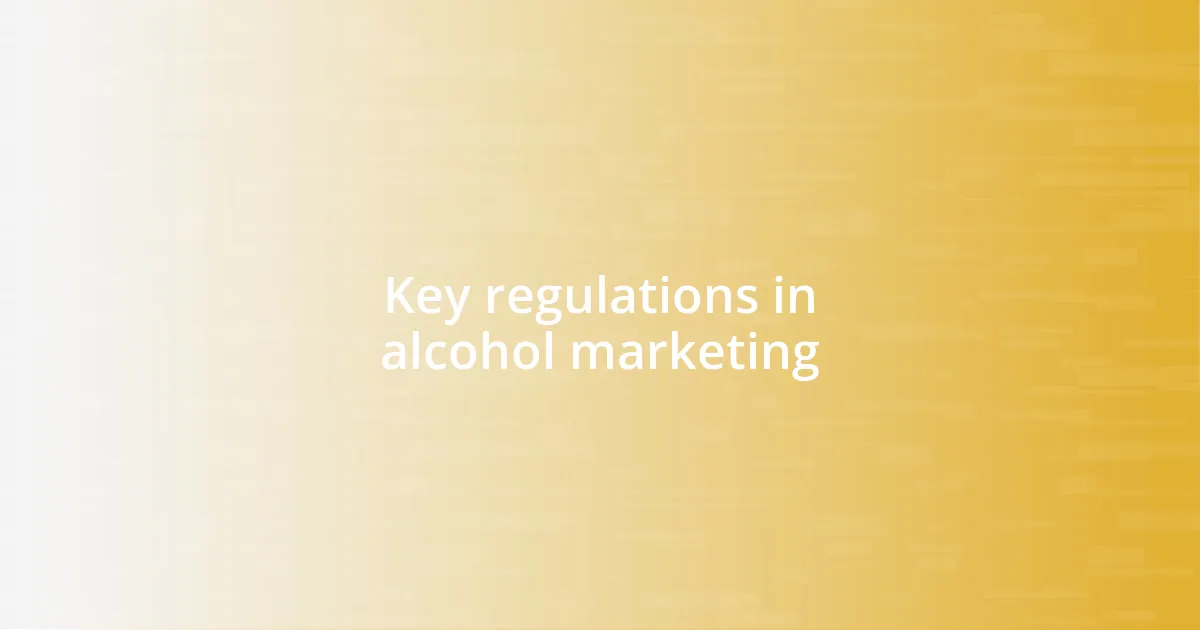
Key regulations in alcohol marketing
Despite the different regulations in place, alcohol marketing often shares common themes across various regions. For instance, many countries impose strict guidelines regarding the portrayal of alcohol in a manner that promotes responsible drinking. I find that when I watch ads where brands emphasize moderation, it feels like they are genuinely attempting to foster a healthy relationship with their consumers, rather than just chasing profit. Isn’t it refreshing when marketing shows a commitment to public health?
In addition to responsible messaging, age restrictions are a cornerstone of many alcohol marketing regulations. Personally, it struck me during a recent event where a brand showcased its new product, but they made it a point to verify ages before letting anyone sample it. This approach not only protects underage individuals but also reassures adults that the brand cares about its impact on society. How often do we see this level of consideration in advertising?
Countries also vary in their rules concerning sponsorship of events and partnerships with influencers. I’ve seen brands sponsor major festivals but struggle to balance promotion while adhering to the regulations. It’s intriguing to see brands navigate these rules, sometimes leading to creative partnerships. Yet, it raises a question: is it possible to celebrate the culture of these products without glamorizing excessive consumption?
| Country | Key Regulation |
|---|---|
| United States | No advertising to those under 21 |
| Australia | No ads during children’s programming |
| United Kingdom | No promotion of excessive drinking |
| Canada | Mandatory health warnings |
| New Zealand | Restrictions on social media marketing |

Evaluating effectiveness of restrictions
Evaluating the effectiveness of alcohol marketing restrictions can feel like peeling back layers of an onion. Personally, I’ve observed that when strict regulations are in place, there seems to be a noticeable shift in how brands communicate with their audiences. For instance, I remember watching a popular sports event where alcohol brands had to pivot from flashy ads to more subdued, responsible messaging. It felt like a breath of fresh air, showcasing a potential turning point in marketing strategy.
However, the conversation around these restrictions is complicated. While I’ve seen some brands genuinely embrace responsible marketing, I’ve also noticed a pattern where others try to skirt around the regulations. Do they truly care about consumer health, or are they simply checking off boxes? There was an instance where a brand cleverly disguised its messaging to appeal to younger audiences while technically adhering to age restrictions. This raises the question of whether the rules are robust enough to create real change or just a playful arena for clever marketing tactics.
In reflecting on my experiences at alcohol-sponsored events, I often find myself contemplating the broader implications of these restrictions. I remember attending an outdoor concert where a brand’s sponsorship seemed to dominate the atmosphere but focused significantly on promoting moderation. It sparked conversations among friends about our own drinking choices, illustrating that restrictions can indeed push brands to think differently about their influence. Are we ready to embrace the idea that effective regulations can lead to a culture of conscious consumption?

Case studies on successful campaigns
One standout case study that comes to mind is a campaign by an Australian brewery, which effectively used local storytelling to promote responsible consumption. They launched a series of ads featuring real-life accounts from community members discussing their healthy relationship with beer. I remember feeling a sense of connection, as their approach transformed the narrative from merely selling a product to fostering community engagement. It made me wonder, can storytelling in marketing genuinely reshape societal views on consumption?
Another impressive example is a UK-based brand that strategically partnered with a health organization to promote a “Drink Responsibly” initiative. I recall seeing their ads highlight the importance of moderation while integrating practical advice for consumers. This collaboration not only conveyed a strong social message, but it also enhanced the brand’s credibility. It left me pondering whether other brands might follow suit and prioritize partnerships that reinforce responsible drinking over mere sales.
Lastly, I can’t forget the innovative campaign by a Canadian distillery that utilized social media to create dialogue around moderation. Instead of focusing on flashy imagery of their products, they shared user-generated content that celebrated responsible drinking moments. When I engaged with their posts, it felt like being part of a movement, rather than just another marketing tactic. It raised a thought for me: can we inspire healthier drinking habits through authentic engagement and community-driven content?

Future trends in alcohol advertising
As I look ahead, I can’t help but notice a shift towards authenticity in alcohol advertising. Brands are starting to prioritize transparency, sharing behind-the-scenes glimpses into their production processes. I recall scrolling through a brand’s social media and seeing a series of posts that highlighted the ingredients used in their craft beers. This transparency resonates with consumers who are increasingly interested in the origins of what they consume—could this trend redefine trust between brands and their audiences?
Another trend I foresee is the rise of digital platforms catering specifically to responsible drinking. Just recently, a friend shared an app designed to help track alcohol intake while promoting healthier lifestyle choices. This combination of technology and social responsibility could create a supportive community around moderation. I find myself wondering, will we soon see more brands investing in platforms that not only advertise their products but also advocate for mindful consumption?
Moreover, the ongoing evolution of regulations may lead to even more innovative approaches. I remember attending a focus group where discussions centered on the impact of ad restrictions on creative strategies. It made me think: what if brands start leveraging augmented reality (AR) to engage consumers in immersive experiences that emphasize moderation? Such cutting-edge tactics could foster a deeper connection while complying with regulations. How exciting would it be for consumers to explore interactive content that educates and entertains at the same time?

Recommendations for policy improvements
To improve alcohol marketing policies, I believe that regulators should consider implementing stricter guidelines on advertising placements, especially on platforms frequented by younger audiences. For instance, I once noticed a flashy ad pop up on a social media feed meant for college students, and it struck me how easy it is for brands to target impressionable demographics. It’s essential that we protect young people from marketing messages that encourage excessive drinking.
Additionally, fostering partnerships between alcohol brands and public health organizations could enhance the credibility of responsible drinking campaigns. I recall attending an event where a well-known brand collaborated with nutritionists to discuss alcohol’s impact on health. It made me realize how powerful these the connections could be—they don’t just promote a product, but also educate consumers. Imagine if more brands took this route instead of solely focusing on boosting sales.
Lastly, I recommend that policymakers promote transparency in advertising by requiring brands to disclose potential health risks associated with alcohol consumption directly within their ads. I can still picture a commercial that glamorized a night out without mentioning anything about moderation or health. By ensuring brands provide balanced information—like a simple warning tag—we promote a culture of informed decision-making. Wouldn’t it be beneficial if consumers had all the facts before their choices?




